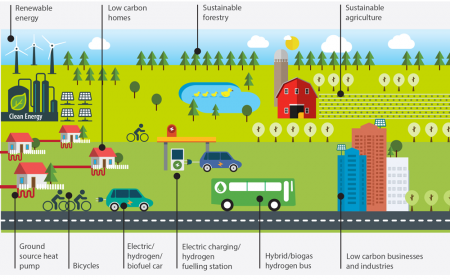May 16, 2016 – It is hard to believe that it only will take $7 billion over the next four years to begin the transition from a fossil fuel-based economy but that’s what is about to be presented to the citizens of the Province of Ontario. Ontario was the first jurisdiction in North America to end coal-fired power back in 2013. That contributed to a significant drop in the Province’s carbon emissions. But to achieve 15% emission reductions below 1990 levels by 2020, 37% by 2030 and 80% by 2050, requires a restructuring of the way people in the Province live and work.
In a 57-page document, entitled Climate Change Action Plan, it outlines 80 policies linked to 32 actions, each with a specific price tag and emission reduction estimate. The $7 billion is to come from the cap-and-trade marketplace that Ontario is joining along with Quebec and California. The Premier describes the plan as transformational, to “forever change how we live, work, play and move.”
The Government of Ontario has incorporated some of the ideas pioneered in New York State to combat climate change. The U.S. state recently launched a $5 billion clean energy fund to advance renewable energy and clean tech industries.
The $7 billion budget breaks down as follows:
- $3.8-billion to retrofit buildings, end the use of natural gas (currently providing 76% of heating in the Province) and replace it with geothermal, solar power or other forms of electric heating. This is expected to remove 3 million tons of carbon from annual emissions.
- Introduction of new building code rules to require the heating of all homes and small buildings built in 2030 or later to be fossil-fuel free, with the rule to be extended to all buildings by no later than 2050. All homes will undergo energy-efficiency audits before sold.
- New incentives for purchasing electric vehicles (EVs) to achieve 5% of vehicles sold by 2020, and 12% by 2025. The budgeted amount $285-million, includes rebates up to $14,000 for every EV purchased, up to $1,000 for homes charging stations, removal of HST on EV sales, and a subsidy program for low to moderate-income households to retire older cars and replace them with EVs. The Province will introduce free overnight EV charging and will build out more charging stations at provincially-owned facilities including liquor store outlets. The end result to have 1.7 million hybrids or EVs in every multi-vehicle driveway by 2024. Also under discussion is making EV charging infrastructure a part of all new building construction.
- $176 million in incentives for fuel retailers to increase biodiesel and 85% ethanol-blends into their products at the pumps. This is expected to reduce the Province’s carbon emissions by 2 million tons.
- Every liter of liquid transportation fuel, gasoline or diesel, sold in the Province is required to reduce life-cycle carbon emissions by 5% by 2020.
- Natural gas providers will also be required to increase renewable content in their products by incorporating biogas and gas-from-waste. This is expected to remove one million tons of carbon from Ontario’s annual emissions.
- School boards will receive $280 million for the purchase of electric-powered buses.
- Trucking companies will be mandated to switch to lower-carbon fuels such as liquid natural gas with the building of appropriate infrastructure to support the transition. This is expected to remove 400,000 tons of carbon emissions annually.
- The GO regional rail network in the Greater Toronto Area of Southern Ontario will see an investment of $354 million to use for electrification and expanded service.
- $200 million is earmarked to expand bicycle lanes and parking to get people out of cars.
- Research and development on clean technologies will receive a boost of $375-million which includes $140-million for the establishment of a Global Centre for Low-Carbon Mobility at a to-be-named Ontario university or college.
- Factories and industrial businesses will receive $1.2-billion to help them reduce emissions through investment in new machinery and technology.
- The Government will earmark $174-million to retrofit its own buildings to reduce their carbon footprints. In addition the government will implement work-from-home strategies to further reduce the use of fossil fuels for transit.
The Plan is not yet official but a formal announcement is expected in June. The reaction of automakers has been of concern leading to a concerted behind-the-scenes effort to reach out to the sector for consultation and in advance of the Plan’s release.
To put the the challenge into perspective it will require the industry to deliver 200,000 hybrid and EV units to Ontario customers every year between now and 2024. For General Motors, Ford, Fiat-Chrysler, Toyota and Honda, all manufacturers within the Province, this amounts to a major sea change, a retooling of assembly lines, and a significant investment in new technology. The targets are far removed from the present reality which amounted to 6,933 total EV sales for all of Canada last year up from 5,235 in 2014. And in Ontario where the companies are being asked to promote EV and hybrid vehicles, to-date the numbers have represented a paltry 2% of all units sold annually.
Strangely missing from what has been shared with the public to date is a strategy to lower carbon emissions in mining, agriculture, forestry and Great Lakes shipping, all significant contributors of greenhouse gas emissions.









